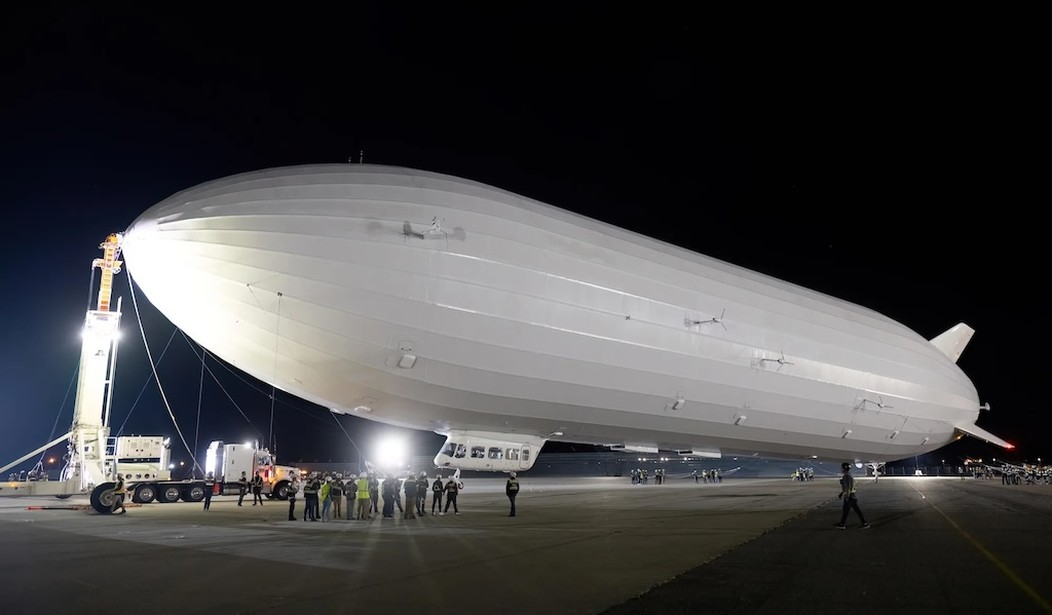What's 600 feet long, 100 feet around, carries 20 tons, can fly 10,000 miles without burning a single drop of avgas, and doesn't exist — quite yet? It's called Pathfinder 3, currently under development by LTA Research in Akron, Ohio, and, once built, the all-electric airship will be the biggest since Goodyear–Zeppelin built the USS Macon (ZRS-5) for the Navy in 1929.
The Macon crashed off the coast of California in 1935, just two years after the Navy commissioned her, but LTA (Lighter Than Air) has higher hopes for Pathfinder 3.
Before we get to that, a quick personal note. Even in the news and opinion business, on occasion, I still get to write a column for the sheer pleasure of it. I hope you'll enjoy reading this one as much as I did researching and writing it.
Last week, LTA debuted the 400-foot Pathfinder 1 prototype at Moffett Field in Mountain View, California. Pathfinder 1's mission is to serve as a testbed for all the new technologies its big brother will require.
They include:
- No fewer than 12 electric motors developed in conjunction with Slovenian light aircraft maker Pipistrel.
- Lidar sensors that will "continuously and accurately calculate the volume of helium in the gas cells."
- DuPont's Tedlar composite for an outer skin that is lightweight, strong, nonflammable, and UV resistant.
- And 13 structural ribs constructed of "3,000 welded titanium hubs and 10,000 multi-ply carbon fiber reinforced carbon tubes."
“It’s been 10 years of blood, sweat and tears,” LTA CEO Alan Weston told TechCrunch on Tuesday. “Now we must show that this can reliably fly in real-world conditions. And we’re going to do that.”
With financial backing from Google co-founder Sergey Brin, LTA hopes to "build airships that are faster, that are safer, more environmentally friendly and have greater capabilities than any airship built before," Weston added. Pathfinder 3's mission is to provide humanitarian relief in places where it's difficult or impossible for traditional heavier-than-air cargo aircraft to reach.
Weston told the Akron Beacon Journal last year, "We believe that lighter-than-air technology has the potential to revolutionize humanitarian relief efforts with its ability to reach remote locations that have little or no infrastructure."
But I have an even more noble mission in mind: pleasure air cruises for people like you and me.
(So maybe "noble" is too strong a word...)
I've had a lifelong fascination with lighter-than-air flight. My great-grandfather raced hot-air balloons back in the first few decades of the 20th century (before getting himself killed behind the stick of an airplane in 1947), and I still have vivid memories of seeing George C. Scott on the big screen in "The Hindenburg" when I was a boy. The big explosion at the end wasn't enough to shake my desire to fly someday in a zeppelin.
When I have the extra time, travel by train is undoubtedly my favorite. I don't mean jillion-dollar high-speed trains to nowhere or crappy, money-losing commuter rail. But rail as a form of tourism — really seeing the scenery, getting to know the countryside — is a real pleasure.
But given the chance to trade in a somewhat bumpy train and its ground-level views for a bird's eye view of the world, complete with all the amenities made famous by pre-Hindenburg airships... where do I sign up?
TAKE MY MONEY.
I'd be remiss if I didn't mention one other story, only tangentially related.
Last week was a yuge one for aviation buffs like Yours Truly. Not only did Pathfinder 1 debut on Wednesday, but the Air Force's new heavy stealth bomber, the B-21 Raider, also took its maiden test flight over Palmdale on Friday. It's a beauty, looking like a sleeker, cleaner B-2 Spirit.
Unlike a fancy passenger version of the Pathfinder 3, I'd just as soon avoid any "pleasure" rides on a B-21 through enemy airspace.
Recommended: What—or Who—Caused That Devastating Freeway Fire in Los Angeles?










Join the conversation as a VIP Member